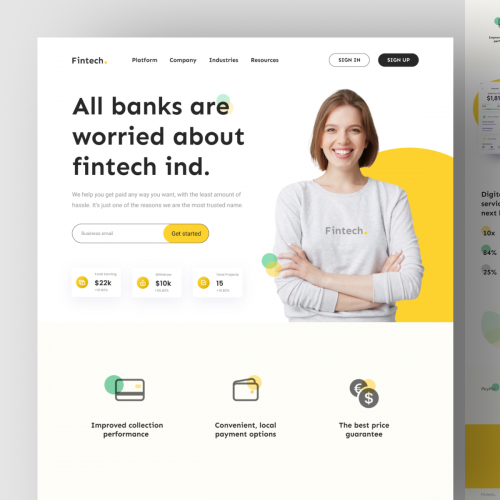Modern Internet Site Layout That Captures Attention and Converts
In a significantly electronic landscape, modern-day internet site layout has actually arised as a pivotal factor in recording individual interest and driving conversions. As we discover these vital parts, it comes to be clear that understanding their interplay can dramatically impact a website's efficiency and individual fulfillment.
Value of Visual Pecking Order
Visual hierarchy is an important component in site style, as it guides individuals' attention and enhances their general experience. By tactically arranging material, developers can direct customers to the most crucial information first, thereby raising engagement and boosting use. Reliable aesthetic pecking order uses numerous techniques, consisting of size, comparison, shade, and spacing. Bigger aspects naturally attract the eye, while contrasting shades can stress essential messages, making them stand out among more restrained parts.
Incorporating a logical flow in material arrangement is necessary; as an example, placing one of the most important details at the top of a page fosters immediate acknowledgment. Consistent use of typography, such as varying font dimensions and designs, aids establish a clear web content structure. This company not just aids in navigating however likewise constructs count on, as individuals really feel much more comfortable when they can easily find what they are searching for.
Eventually, a well-executed visual power structure not only improves aesthetic appeal but likewise considerably impacts customer actions. By prioritizing crucial aspects and guaranteeing a seamless experience, developers can properly transform site visitors into clients, strengthening the importance of this fundamental style principle in modern-day web site development.
Responsive Design for All Instruments
Producing a smooth experience throughout various devices is important in today's electronic landscape, where individuals accessibility web sites from desktop computers, mobile phones, and tablets alike. Responsive design is a vital technique that makes certain websites adapt fluidly to different display sizes, resolutions, and positionings. By utilizing versatile grids, images, and CSS media questions, designers can produce layouts that maintain visual honesty and performance, no matter the tool being utilized.
The significance of receptive style extends past appearances; it straight impacts individual interaction and conversion rates. A web site that functions well on all tools urges longer check outs and minimizes bounce rates, as customers are most likely to interact with web content that is very easy to navigate. Moreover, internet search engine, particularly Google, prioritize mobile-friendly websites in their rankings, making responsive style a vital component of search engine optimization (SEO)
Including responsive style not just enhances user experience however additionally enhances the development procedure. By creating a solitary site that works throughout tools, services can conserve time and sources contrasted to developing separate mobile and desktop versions. Eventually, receptive layout is a fundamental technique for modern site style, guaranteeing availability and complete satisfaction for all customers, regardless of their device.
Engaging Interactive Elements
While a responsive style prepares for a practical internet site, including engaging interactive components is essential for catching individual interest and cultivating much deeper links. Website Design. Interactive components, such as computer animations, tests, and clickable infographics, develop an extra vibrant customer experience, motivating visitors to invest more time on the website
Including interactive attributes can also guide customers with complicated details, making it easier to absorb material. For instance, interactive sliders can show product variants, while embedded videos can provide demonstrations or testimonials that reverberate even more than static images or message. Gamification techniques, like benefits for involving or completing jobs with content, can boost individual inspiration and retention.
Reliable use interactive aspects not just enriches the customer experience but can likewise result in greater conversion rates. By making communications insightful and pleasurable, my response organizations can cultivate a feeling of commitment and count on with their target market. However, it is vital to stabilize interactivity with efficiency; excessively complex attributes may impede website rate, adversely affecting user contentment. Eventually, incorporating properly designed interactive elements can substantially boost a website's effectiveness, driving Website Design involvement and conversions in today's affordable digital landscape.
Structured Navigation Practices
Reliable navigation is a cornerstone of any kind of effective website, as it straight influences customer experience and web content availability. Structured navigating techniques make certain that customers can easily find info, boosting their interaction with the site. A well-structured navigation menu need to be basic and user-friendly, generally featuring a limited variety of main classifications to prevent overwhelming visitors.
To attain streamlined navigating, designers should focus on a hierarchical structure that logically arranges material. Executing breadcrumb routes can give customers with context regarding their current location within the website, enabling smooth backtracking. In addition, making use of drop-down food selections can effectively conserve room while still giving accessibility to subcategories.
Receptive layout is essential, as navigating should be functional throughout all gadgets (Website Design). Mobile individuals, specifically, gain from touch-friendly menus and retractable sections that keep functionality without compromising aesthetics

Effective Call-to-Action Approaches
A well-crafted call-to-action (CTA) is vital for assisting customers toward preferred end results on a web site, as it encourages them to involve with content or buy. To optimize their effectiveness, CTAs must be clear, compelling, and purposefully placed throughout the website.
First, use action-oriented language that interacts necessity or value, such as "Get Started," "Join Currently," or "Case Your Discount rate." This language not just motivates individuals yet also establishes clear expectations concerning the following steps.
2nd, consider design elements; CTAs must stick out aesthetically through contrasting shades, enough whitespace, and popular positioning. A button that is simple to see and click rises the possibility of individual communication.
Additionally, personalizing CTAs based on customer behavior or demographics can substantially enhance involvement. Tailored messages resonate a lot more with individuals, driving greater conversion prices.

Conclusion
In conclusion, modern web site layout emphasizes the combination of aesthetic hierarchy, responsive designs, involving interactive components, streamlined navigation, and efficient call-to-action approaches. These components collectively enhance individual experience, ensuring that visitors stay involved and encouraged to discover content additionally. By focusing on these style concepts, companies can dramatically improve individual retention and conversion prices, inevitably leading to greater success in the digital landscape. The constant advancement of website design underscores its essential role in effective on-line interaction and advertising.
In an increasingly electronic landscape, contemporary website design has arised as an essential variable in catching individual interest and driving conversions.Visual power structure is a critical component in site design, visit this page as it guides users' focus and improves their overall experience.The importance of receptive design prolongs beyond visual appeals; it directly affects user involvement and conversion rates.Incorporating receptive design not just improves customer experience however also simplifies the advancement process. Inevitably, responsive design is a basic technique for modern-day web site style, ensuring accessibility and contentment for all customers, no matter of their gadget.